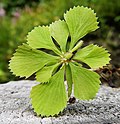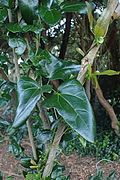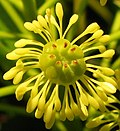| Flowering plant families (APG IV) | |||||
|---|---|---|---|---|---|
| Early-diverging flowering plants | |||||
| Monocots: Alismatids • Commelinids • Lilioids | |||||
Eudicots
|
The basal eudicots are a group of 13 related families of flowering plants in four orders: Buxales, Proteales, Ranunculales and Trochodendrales. [1] [a] Like the core eudicots (the rest of the eudicots), they have pollen grains with three colpi (grooves) or other derived structures, [4] and usually have flowers with four or five petals (sometimes multiples of four or five, sometimes reduced or fused). [5] Unlike other eudicots, they sometimes have flowers with petals in twos or multiples of two. [6]
Contents
- Glossary
- Dilleniales and Gunnerales families
- Basal eudicot families
- See also
- Notes
- Citations
- References
The basal eudicots include trees, shrubs, woody vines and herbaceous plants. [7] Cultivars of Buxus are used for hedges and topiary, and the high-quality wood is commonly used for decorative carvings and musical instruments. [8] The sacred lotus is the national flower of India and Vietnam, and the waratah is the floral emblem of the Australian state of New South Wales. [9] The opium poppy, Papaver somniferum , a source of morphine, was cultivated thousands of years ago in Mesopotamia. [10] Macadamia nuts are mainly grown in Hawaii and Australia. [11]
The orders Dilleniales and Gunnerales are basal within the core eudicots. Species of Gunnerales often have serrate (serrated) leaves, with flowers similar to those of Buxales. The epidermis and hairs on species of Dilleniales are often full of silica. [12] [13]

































